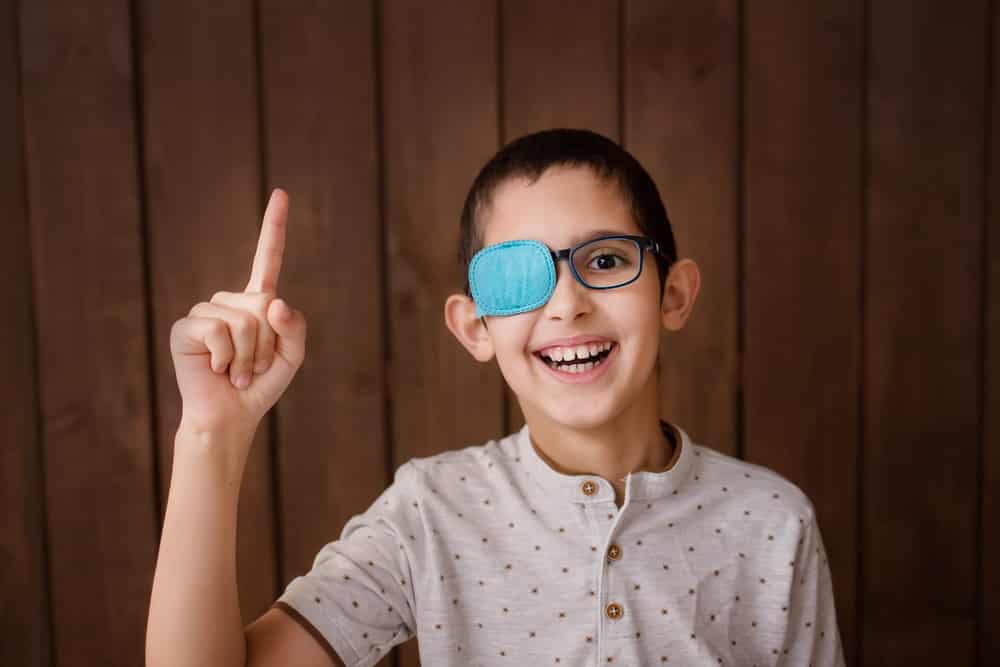Have you noticed that your child often squints or struggles to concentrate? These can be signs of amblyopia, or a lazy eye beginning to develop. But what causes a lazy eye? And how can you help your child recover from it?
What Causes a Lazy Eye?
When you were younger, maybe you knew a child in your class or neighborhood that wore an eyepatch or thick glasses. Maybe you even wore these things yourself. If so, you’re probably aware that sometimes these are treatments to correct a lazy eye. But what causes a lazy eye?
Understanding “Amblyopia”
“Amblyopia” means “uneven vision,” or literally a “lazy eye.” In other words, a lazy eye can occur when one of the eyes is affected by an issue that allows it to develop less control than the other eye. When this happens, a person’s vision will come to rely on the stronger eye. As a result, the weaker eye can develop a tendency to wander inwards or outwards instead of pointing straight ahead. A lazy eye typically occurs between infancy and the age of seven and can be cured if diagnosed early enough. If it is not addressed, this can lead to larger vision problems down the road, such as nearsightedness.
Anything that blurs or affects a child’s vision can result in a lazy eye. This includes:
- Differences in muscle strength between the eyes. If one eye is stronger than the other, the weaker eye can struggle to work effectively with the stronger one.
- Anything that causes temporary blindness or vision issues in one eye but not the other, like cataracts.
- A significant difference between one eye’s prescription and the other, leading the patient to rely more on the stronger eye.
Family history is also a significant factor for lazy eye. If crossed eyes or vision problems run in your family, it’s a good idea to ask an optometrist to screen your child for amblyopia at regular checkups.
How Do I Know If My Child Has a Lazy Eye?
You may think it would be obvious if your child has or is developing a lazy eye. However, it isn’t always easy to spot, and sometimes it requires a doctor’s visit to confirm. If you’re concerned that your child might develop lazy eye, look for the following symptoms:
- Squinting, tilting their head, or frequently repositioning in order to see something more clearly
- Poor depth perception, which can sometimes give the impression of clumsiness
- Eyes that do not appear to work together or focus on the same thing at the same time
- Eyes that wander out of focus
If you notice any of these symptoms, you should immediately take your child in for an eye exam. In general, all children between the ages of three and five should have at least one comprehensive eye exam. If they have vision issues, they may need to visit a little more often. Your optometrist can help you spot the problem if it exists, and determine a schedule for follow-ups if needed.
What Can I Do About Lazy Eye?
If your child is diagnosed with lazy eye, don’t panic! It is typically easily corrected through patching therapy or the right prescription. In some situations, more intervention might be needed. However, for most people with lazy eye, a complete recovery is very possible. Untreated lazy eye can result in various complications, ranging from those mentioned above to a complete loss of vision. So if you suspect lazy eye might be an issue, it’s better to be safe than sorry.
_____
What causes a lazy eye? It depends on the situation, but anything that affects your child’s vision in one eye but not the other can result in amblyopia. Early detection is the key to a cure. If your child hasn’t seen an optometrist in a while, why not make an appointment?
Are you looking for an optometrist to answer your questions? If you live near southwest Missouri, stop by Heffington’s. Since 1975, the Heffington family has been assisting the Springfield community with top-quality eye care and affordable eyeglasses and contacts. To learn more about our products and services, please get in touch with us online, send an e-mail to asktheexperts@heffingtons.com, or give us a call at 417-869-3937 (Optiland location) or 417-882-3937 (House of Vision location).

